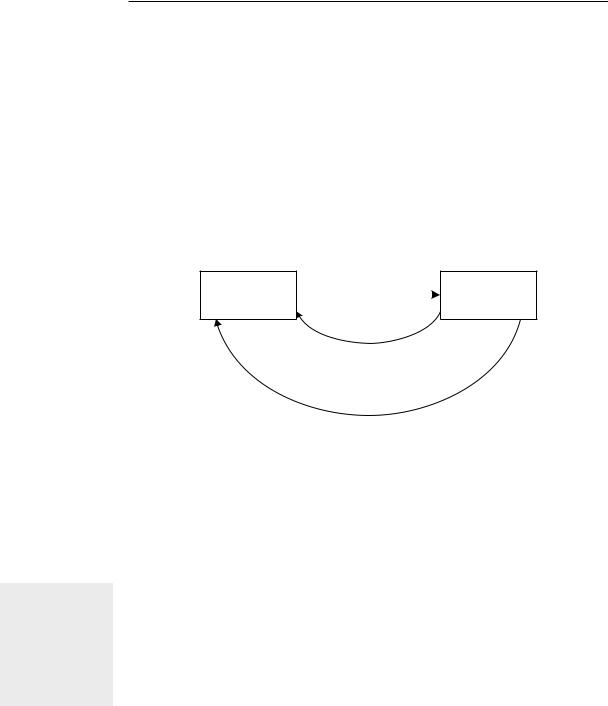
project_management_made_easy
.pdf
Teamwork and Communications
We have to begin with the clear project plan we’ve built using the tools in Chapters 4 through 9. After that, we review the action plan to determine what skills are needed to do the job. Then we work with the team we have to evaluate their skills in terms of the job to be done. We do a gap analysis, finding out what skills, if any, are missing.
Sometimes, we’re lucky and our team has all the skills—all the proven, successful experience—to get the job done. That usually happens if the project is not unique, not that different from work that the team has done before. In that case, we have our team and the challenge is then to schedule the work around other projects and routine work and things that we need to do.
Sometimes, though, we find that there is a gap, that some knowledge or some skill is missing from the team. Our first thought should be: closing this gap will take time and money. It also adds risk, because closing the gap can be done only with one of two options:
Someone on the team learns something new. In that case, he or she will be doing it for the first time on this project, and there is always the risk of making a mistake.
We bring in an expert. In that case, the new person on the team is an unknown factor. What if he or she turns out not to be reliable or is unable to work well with our team?
Our best bet is to define the gap clearly and close it early. Through research or training or hiring an expert or consultant, we get the knowledge we need.
Iteration, Course Correction, and Plan, Do, Check, Act
There are three ideas underlying the approach in this chapter.
Iteration means doing something over and over again. So, we define each gap and close it, until there are no more gaps.
Course correction means frequently checking our course and adjusting to move in the right direction. We’ll talk about this more in Chapter 13, Keeping Everything on Track.
Plan, Do, Check, Act (PDCA) is a valuable problem-solving technique from quality management that we discuss fully in Chapter 16, Quality: Eliminate Error.
The Lesson: Find what’s wrong, then fix what’s wrong, over and over, until the wheel is spinning true.
When people lack skills,
don’t blame. Instead, help them get the skills.
87

Project Management for Small Business Made Easy
We do this for each gap between the team skills and the skills needed for the project. Then we reassess the whole set of skills: do we have what we need now? And we assess if we need to do anything to pull in any new team members. Then we change our action plan to include the new people and skills. We have to coordinate training time for the team or the availability of new people with the project schedule and adjust the project schedule. Then we reassess risk. Are all the risks clear? Is the level of risk for the whole project acceptable? If so, we’re ready to go. If not, we take whatever corrective action is necessary.
Once we have good people with the right skills, we have the resources for the project. However, those resources have to work together well. The next three sections talk about how we can make that happen. But we can’t do it alone. Just as we work with the team, the team has to work with us.
Just recently, I met Bruce Runcie, the owner of Rose City Estate Gardens, a small landscaping business that focuses on special projects. He’s been in the business over 25 years and he’s defined the qualities that make someone a good worker, good team player, and potential right-hand man or woman. Here are the five qualities he said were essential, with the acronym HIRAST:
Honesty. Teamwork requires that people obey laws and rules and also that we be truthful with one another.
Interest. Each of us has to care about the job and want to improve in the type of work we are doing. It won’t work if this job is just a waystation onto something different.
Reliability. Each team member must be willing to show up and do the work and to keep the commitments necessary for the job to be done and for the business to succeed.
Attitude. A positive attitude and concern for the customer are essential.
Skill or Teachability. The person must have the necessary skills for the job. Or, if all four other elements are present and the person is willing and able to learn, that can work as well.
Our best bet is to hire people with these qualities. If we don’t, then we’ll have some degree of hassle every day as they work with us. When we’re working on projects, this kind of hassle is particularly difficult, for two reasons. First of all, projects are unique, so people need to be willing to grow and learn to make a project succeed. Second, projects have deadlines, and the hassles
88

Teamwork and Communications
that come with people lacking the HIRAST qualities make it very hard to keep the work flowing smoothly on schedule. If we are running a project and falling into perpetual hassles or things aren’t getting done on time, we should check our team members and ourselves against the HIRAST list. If we find a gap, we’ll need to either close it or work around it. Sometimes, we’ve dropped the ball from burnout or exhaustion. Sometimes, talking about these issues and making a commitment to a renewed effort works. Sometimes, we have to either ask someone to leave the team or just live with the problem and work around it as best as we can.
Defining Jobs Clearly
If the team members are willing to do the work, then it’s our job to work with them so that they know what to do. We start with the WBS and action plan from Chapter 6, What Are We Making? Working with each team member, we make the job clear at the detailed level. At a minimum, each worker should have a clearly defined goal for each day of work. Less experienced workers may need tasks defined down to the level of one or two hours.
The key to making this work is to define tasks clearly and completely. We’re talking about the basic unit of work, which is sometimes called a task, or an action, or a step. Whatever we call it, an action is something we do that leads to a clear result. The full picture of a task or action is shown in Figure 10-1, the parts of a job, also called the I-P-O (Input-Process-Output) diagram.
Input |
Process |
Output |
Tools |
|
|
Techniques |
|
|
Resources |
|
Work |
|
|
Environment |
Figure 10-1. The parts of a job
89

Each worker gets the job done right. The manager makes
sure that is possible.
Project Management for Small Business Made Easy
When I set up a job for someone, it’s my job as a manager to make sure that all seven parts of the job are in place. It is the worker’s job to check that with me, make sure he or she can do the job, commit to doing it, and then deliver. Here are the seven parts:
Input—the items that go into the process and become part of the output.
Process—the actual activities the worker will do.
Output—the end result: the item to be delivered, the due date, and the delivery location.
Tools—anything the worker needs to do the job that is not used up in the process, that can be used again.
Techniques—the written instructions for the process and also any job skills necessary to follow those instructions and do the work.
Resources—the time spent and anything else that is used up in the process, but does not become part of the product.
Work environment. The place the job is to be done, which must be a safe work environment and should also support effective, efficient work.
For each job, I review each of these points with the worker before the work starts. We take care of any problems we see. I also make sure that the
Too Much Information!
It may seem like discussing seven points about each task is way too much planning. And sometimes we do need less planning. Putting on a good publicity event takes less work than building a jet aircraft with over a million preci- sion-engineered parts. We should rightsize the planning to the type of work, the experience of the worker, and the task. I’ve found that if I share Team Success™ methods with a cooperative team, we do this naturally and easily. After a while, people scan the list of seven questions and say, “No problem, no problem, no problem, . . . wait, I don’t understand this.” Then we work it out.
As you do this, be sure to use the ten qualities of a good requirements specification from Chapter 6, What Are We Making? Also, keep in mind that each unnecessary step in planning may waste an hour, but each hour of planning you should do and don’t will cost you ten hours of project work time.
The Lesson: Start by planning a little too much, and then have the team settle down to just the right amount.
90

Teamwork and Communications
person feels taken care of and supported. I let the person know that I expect him or her to focus on doing a great job and to let me know right away if there is anything that he or she needs.
Supporting Self-Management
The more each person takes charge of his or her own work and gets it done right, the more likely the project is to succeed. Also, people are more motivated and enjoy their work more when they figure out how to do a job themselves. So, I don’t micromanage. Instead, I teach all the tools of planning and management. You might say that I turn each worker into a project manager for his or her part of the project.
Most small business owners find that it is risky to delegate jobs to employees. Most often, we find that the job doesn’t get done as well as we ourselves would do it. With the approach in Project Management for Small Business Made Easy, you can minimize that difference. If the worker has the HIRAST qualities listed above, then he or she can start on small tasks and work up to larger and larger tasks with clear self-management. If we teach the seven parts of the job, then ask the worker to check those seven parts, we teach the worker to walk through the work, planning ahead and avoiding problems. Sometimes, the worker will take our advice and do things the way we know works. Other times, the worker will learn on his or her own, but we make sure the mistakes are small enough to be affordable. And sometimes, we find the worker is better at the job than we could ever be. That’s when we know we have a team.
Creating this friendly, professional, success-oriented environment has another real plus to it. We reduce employee turnover and churn. Employees discover that being treated well is rare—and being trusted is even rarer. Employees stay with bosses who provide support and companies that provide opportunities for professional growth and learning.
Supporting Effective Team
Communications
Effective communications is essential to project success. So often, we leave out one small detail and then we have to redo the work. To prevent this, we have to teach our team members to think through details, request what is needed in
Bad news is good news.
When we hear bad news, we can fix the problem fast.
91

Good customer service is just
this: understand the job, do the job, and check that the customer is happy.
Project Management for Small Business Made Easy
detail, and work together to get it done right the first time. Even worse, it is only human to get frustrated, upset, or even angry when things don’t go well. If we do this as managers, though, we send a message: I don’t want to hear bad news. And, of course, we do want to hear bad news. The sooner we hear bad news, the sooner we can fix it.
When it comes to communications, we have to lead by example. If we communicate clearly and effectively; if we thank people for telling us what’s going on, even when the news is bad; and if we apologize when we make a mistake and get a little snippy, then our team members will be open to learning to do likewise.
When the team is ready to learn, show them Figure 10-2 and explain why both levels of feedback are essential.
Request
Person 1 |
|
Person 2 |
|
Level 1 Feedback: Communications “I hear you. Do I have it right?”
Level 2 Feedback: Action Delivery of the product— “Is this what you wanted?”
Figure 10-2. The two levels of feedback
Feedback is information that we receive that allows us to correct our course.
Let’s say that you want to tell me what to do. After you speak, I repeat back a short version of the instructions. If I got it right, you let me know. If not, you correct my understanding, and we check again. That’s level-1 feedback. Now, I know what I’ve agreed to do. But I still have to do it! Doing the work and then asking, “Is this what you wanted?” is level-2 feedback. Now, either you have what you want or you tell me what I need to do to fix it. If you think of a waiter at a restaurant, level-1 feedback is when he checks to make sure he got your order right and level-2 feedback is when he delivers the food you ordered and makes sure you don’t need anything else.
92

Teamwork and Communications
When we have a project plan and then all team members make a habit of doing good level-1 and level-2 feedback, something wonderful happens. We get a highly effective process called customer service within the team. Remember: our project action plan is essentially linked tasks, with the output of one task being the input for the next task. Now that each task is clearly defined, team members go to the next person in line and say, “My output is your input. If I give you this, will you have everything you need to do a good job easily?” The future recipient of the work defines exactly what he or she is going to need. Then the first person does the work, delivers it, and asks, “Is this all you need?” The recipient checks the work and almost always it’s just right. Then that worker gets going. And when he or she does, the focus is on quality. Instead of facing the hassle of running around to find things and fixing inputs, the worker has everything right there and gets to work to deliver excellent results. This goes all the way down the line to the delighted customer at the end of the project.
As managers, we just grease the wheels and keep them rolling. We make sure that the clearly defined requests that specify outputs are written down and we make sure that all seven elements of each job are available to the workers.
Conclusion: Team Success™
If there is one idea that underlies this whole approach, it is cooperation. We work with our team. Our team works with us on the project. And we all work to make sure that the customer gets whatever features will provide the benefits that deliver the highest value. The beauty of this approach is that it’s not just a win for the customer and it’s not just a win for the company. It’s a win for the team, as well. It’s what I call win-win, all the way around.
Remember the three steps of a project: prepare, do, and follow through? Well, your preparations are almost done. Two more chapters, Chapter 11, Getting What You Need, which talks about purchasing, and Chapter 12, Pulling the Plan Together, will leave you fully prepared for a project that will speed its way to success.
The workers keep working
and we keep everything rolling all the way to success.
93

Chapter 11
Getting What
You Need
THE FORMAL NAME FOR THE SUBJECT OF THIS CHAPTER IS PROJECT
Procurement Management. That name is just too fancy. Also, most of what the Project Management Institute teaches about putting out requests for proposals, comparing bids to select vendors, and managing contracts doesn’t apply to us small
business folks, anyway. So, in Chapter 11, Getting What You Need, I focus on the following issues:
Purchasing for projects
Getting expertise
Getting information
Getting permission
Evaluating vendors
Tracking and saving money in the purchasing process
Although this work is a small part of our project, doing it well is a big prevention of project problems. Everything we need from outside the project— every external dependency—is a project risk. So some extra attention is called for to prevent problems.
94

Getting What You Need
In fact, I ran across a project procurement problem today, as I was writing this book. I’m working on arranging an event and certain things need to be in place before the event. One of them requires a permit. This is going to create a big delay, because I’m dealing with a company that makes stone monuments that operates out of the stone age. They don’t do e-mail. They won’t do a contract by fax, because they need original signed copies. So, everything has to go through the mail to three people, which adds a week or two to the project. In this case, if we miss a certain date, the event will be delayed by another four months. So I’m spending time calling people to ask them to be ready to check their mailboxes so that they can sign documents and mail them to other people. If all that works, the whole thing might work out. But I can’t be sure, because there’s a subcontractor involved and no one will talk to him until all the paperwork is signed.
If I were doing the same work in an industry that used e-mail and accepted faxed signatures, all this work would be done in an afternoon. Instead, all I can do is put it in motion, spend all next week making reminder calls, and keep my fingers crossed. That’s what I mean by hassle. In small companies, we project managers spend our time taking care of that stuff, either because there’s no one else to do it or because we want our team to get the work done, so we push the hassles out of the way.
Poorly planned purchases are
project pitfalls.
Purchasing for Projects
There are a few lessons from the story of the stone monument paperwork:
The only way to find out all the rules, glitches, and possible delays is to talk with everyone. And even then, someone usually leaves something out.
Projects are unique, so purchases for projects are often unique. We may be buying something from an industry we’ve never dealt with before. When we don’t know the ropes, we’re more likely to make assumptions and mistakes.
One little delay causes an endless hassle. This is especially true when you’re dealing with multiple vendors and permits. Anyone who’s tried to buy a piece of property—dealing with owners, real estate agents, mortgage brokers, mortgage lenders, assessors, and inspectors—knows exactly what I’m talking about.
T he moment you are work-
ing with someone new, everything gets three times harder.
95

On a project, the cost of
the hassle is a lot higher.
Project Management for Small Business Made Easy
On a project, those hassles and delays add up to missed deadlines. In routine production work, we consider all the hassles to be part of the cost of doing business and live with it. But, in project management, the delays in each step mean lost work time for the team, missed deadlines, and a cascading series of delays that can lead to major loss of value or even failure of the project.
Because of these three problems, we have to pay more attention to a purchase for a project than for a routine office purchase. Here are some tips:
Plan and make purchases early. Give yourself plenty of lead time.
Let your vendors know that you are on a project and that getting it done right and getting it on time are crucial to your success.
Can’t My Administrative Assistant Handle This?
Project purchasing seems like the ideal job for an administrative assistant. And, after the plan is done, it is. During planning, we need to take the lead, because planning the right purchase often requires talking with several experts and learning a lot. But, when it comes to ordering things and taking care of communications and paperwork, it seems like an administrative assistant would be ideal.
An ideal administrative assistant would be ideal. Unfortunately, such a person is—according to most small business owners I talk with—very hard to find. The clear thinking and attention to detail that it takes to talk with others on the phone—people they have never met—and get those people to get the job done right are very rare. Even if the administrative assistant keeps track of everything and calls everyone, he or she may not have what it takes to get others to do what they need to do. Also, workers tend to think that if they get four out of five jobs done, they’ve done really well. But, on a project, that’s like fixing four out of five problems with the car, but forgetting to fill the gas tank. The project won’t go anywhere unless every external dependency gets it done right.
So it takes an unusually excellent administrative assistant to do this kind of work. And it takes an unusually courageous project manager or business owner to put the fate of a project in the hands of an assistant. I have managed to train people to the job a couple of times, but it has never been easy.
The Lesson: Something small business owners wish wasn’t true, but is all too often, is the adage: If you want something done right, do it yourself. We should do our best to get past that and delegate. But we should also realize that project success may require that we keep on top of purchasing details.
96
